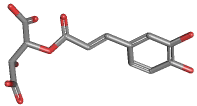|
CAFTARIC ACID |
| Synonyms. Caftaric Acid; Monocaffeyltartaric acid; trans-Caftaric acid; 2-Caffeoyl-L-tartaric acid; (R-(R',R'-(E)))-2-(3-(3,4-Dihydroxyphenyl)-1-oxo-2-propenyl)-3-hydroxybutanedioic acid; |
|
|
| PRODUCT IDENTIFICATION | |
|
CAS RN |
67879-58-7 |
|
EINECS RN |
|
|
FORMULA |
C13H12O9 |
|
MOLE WEIGHT |
312.23 |
|
H.S CODE |
2918.99.4300 |
|
SMILES |
C([C@@H]([C@H](C(=O)O)O)OC(\C=C\c1cc(c(cc1)O)O)=O)(=O)O |
|
CLASSIFICATION |
Hydroxycinnamic acid |
|
EXTRA NOTES |
Other RN: 72880-50-3 |
|
|
| PHYSICAL AND CHEMICAL PROPERTIES | |
|
PHYSICAL STATE. |
white to off-white crystalline powder |
|
MELTING POINT |
124 ~ 125 C |
|
BOILING POINT |
|
|
DENSITY |
|
|
SOLUBILITY IN WATER |
|
| SOLVENT SOLUBILITY |
|
|
VAPOR DENSITY |
|
|
log P(octanol-water) |
|
|
VAPOR PRESSURE |
|
|
AUTOIGNITION TEMP |
|
| pK |
|
|
REFRACTIVE INDEX |
|
|
FLASH POINT |
|
|
|
| STABILITY AND REACTIVITY | |
| STABILITY | Stable under normal conditions. |
|
INCOMPATIBLE MATERIALS |
Strong oxidizing agents |
| POLYMERIZATION |
Has not been reported |
|
NFPA RATINGS |
Health: 1, Flammability: 0, Reactivity: 0 |
|
|
| EXTERNAL LINKS & GENERAL DESCRIPTION |
|
USA.gov - Caftaric Acid Wikipedia Linking - Caftaric Acid Google Scholar Search - Caftaric Acid U.S. National Library of Medicine - Caftaric Acid PubChem Compound Summary - Caftaric Acid http://www.ncbi.nlm.nih.gov/ - Caftaric Acid http://www.sigmaaldrich.com/ http://www.calwineries.com/ |
|
|
| SALES SPECIFICATION | |
|
APPEARANCE |
white powder |
|
ASSAY |
98% min |
|
MELTING POINT |
124 ~ 125 C |
|
LOSS ON DRYING |
1% max |
|
HEAVY METALS |
10ppm max |
|
|
| TRANSPORT & REGULATORY INFORMATION | |
|
UN NO. |
|
| HAZARD CLASS |
|
| PACKING GROUP | |
|
|
| SAFETY INFORMATION | |
|
HAZARD OVERVIEW |
GHS (Globally Harmonised System) Classification: Not a dangerous substance. Potential Health Effects: Eyes - May cause eye irritation. Skin - May be harmful if absorbed through skin May cause skin irritation. Inhalation - May be harmful if inhaled. May cause respiratory tract irritation. Ingestion - May be harmful if swallowed. |
| HAZARD CODES |
|
|
RISK PHRASES |
|
|
SAFETY PHRASES |
|
|
|
| PACKING |
|
Preserved in light-resistant and well-closed bottles |
|
|
